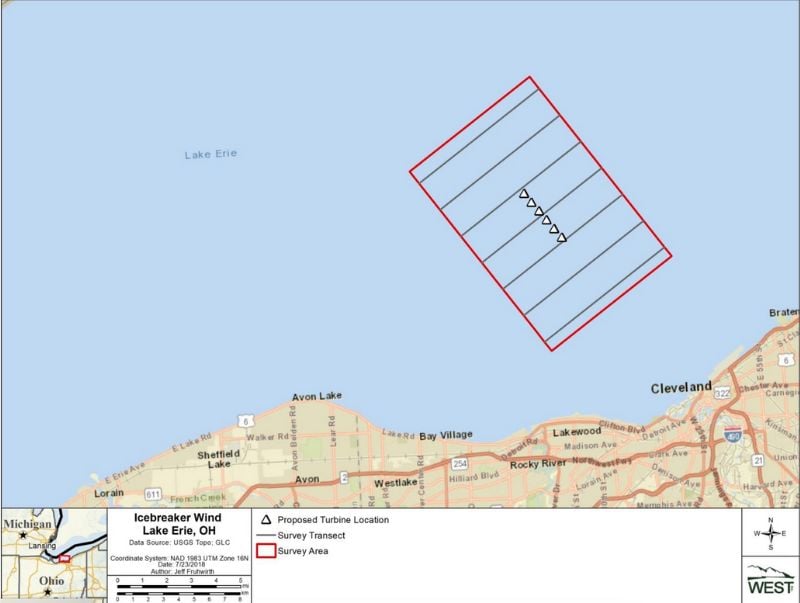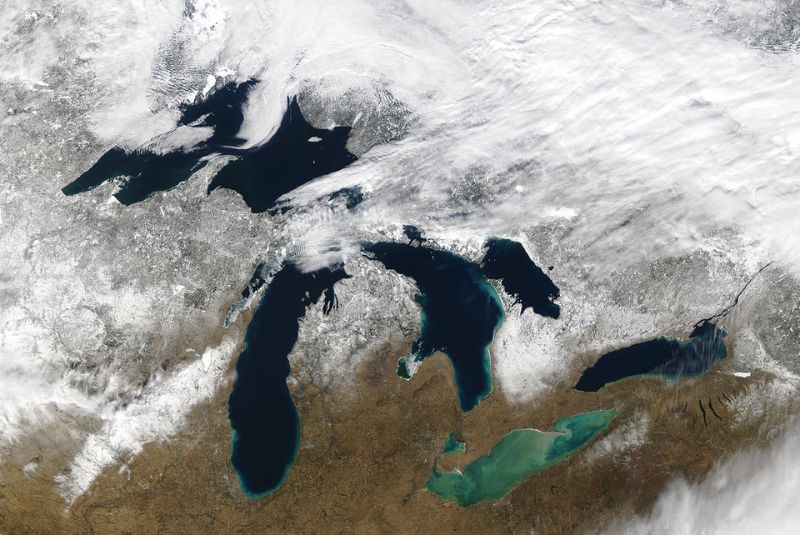Up in the Air: The Future of Great Lakes Wind
What will it take to bring wind power to the Great Lakes? EEPower spoke to the National Renewable Energy Laboratory about how lake-based wind turbines could help states reach renewable energy goals—but only if unique problems are addressed.
Energy from offshore wind farms in the Great Lakes could serve about 34 million people in the U.S. and Canada. But no wind project has succeeded so far. All offshore wind turbines in the U.S. are currently located in the Atlantic Ocean.
Floating offshore wind farm. Image used courtesy of Adobe Stock
While Great Lakes wind seems enticing, lake-based wind turbines face challenges that offshore ocean wind farms don’t. Yet, once these issues are overcome, Great Lakes wind will likely become an important part of the energy mix within the next 30 years, said Walter Musial, Chief Engineer for Offshore Wind at the National Renewable Energy Laboratory (NREL).
Musial discussed the advantages of offshore wind in the Great Lakes and the challenges in developing these projects in an interview with EEPower.
Status of Great Lakes Wind Projects
Past efforts in Great Lakes wind farms have stalled or not advanced beyond conceptual stages. The once-promising Icebreaker Project, set to place six wind turbines in Lake Erie near Cleveland, paused in December 2023 due to rising costs and other issues.
Location of Icebreaker Project. Image used courtesy of Pacific Northwest National Laboratory
Eight states border the five Great Lakes, but they’re all talk and no action so far.
“It’s not a project until the state has some collaborative interest in developing it, and there’s utility interest and a clear path forward,” Musial explained. “So there’s interest, let’s say, but I wouldn’t say there’s a project you can point to.”
In Illinois, state legislature and other stakeholders have discussed a wind farm project in Lake Michigan since at least 2012, when the Illinois Department of Natural Resources conducted a feasibility study. Not much has happened since, and the project status is up in the air.
“I would call it a pre-planning stage,” Musial said.
New York, which borders Lake Erie and Lake Ontario, also conducted a feasibility study in 2020.
Advantages of Great Lakes Wind
Musial believes the Great Lakes states will have to consider offshore wind to meet their renewable energy goals. The national goal to produce energy with net-zero carbon emissions is 2050, but some states set deadlines even earlier.
The regions along the lakes produce carbon emissions 20 times greater than the national average, according to the National Oceanic and Atmospheric Administration. To meet decarbonization goals, the states must reduce or offset their carbon footprints.
“Those states are going to need to look to all their opportunities, all their options for renewable electrification, non-carbon electrification, and non-carbon emissions,” Musial stated.
Musial explained that the states will start looking to the Great Lakes as land-based sites for large-scale wind or solar become harder to find.
Great Lakes. Image used courtesy of National Oceanic and Atmospheric Administration
The lakes offer other advantages compared to ocean-based wind turbines.
“The extreme waves are less,” Musial said. “So the hydrodynamic loading will be more manageable, and we don’t have the tropical storm conditions.”
Freshwater is also kinder to turbine materials than salty seawater, which causes corrosion on steel structures.
Lake winds are as strong as in the Atlantic and could be more reliable. Turbines placed in the middle of the lake would be unobstructed and could catch winds from any direction. The flexibility is an advantage.
“In the Atlantic Ocean right now, the wind farms are kind of stacked along the prevailing wind direction,” Musial said.
Wind projects could also benefit the states economically. Building a wind farm will need manufacturing, transportation, and port development and operations.
“There’s a lot of potential for heavy industry to be reintroduced into some of those regions because of the supply chains that would be built there,” Musial said.
The states could also receive revenue from leases and taxes.
Engineering Challenges for Great Lakes Wind Infrastructure
Floating offshore platforms will likely be the preferred design for wind farms. Lake depths vary but can reach 400 meters in some places.
The most prominent challenge will be the cold. All five lakes freeze over to some extent every winter.
“Everybody asks about ice and icing,” Musial said. “The wind turbine substructures have to be designed to withstand and break the ice as it flows through.”
Ice on Lake Superior. Image used courtesy of National Oceanic and Atmospheric Administration
The wind farms must be designed with an icebreaker technology to break up the massive ice sheets.
“We might have a similar ice challenge for the electric cables, where they might interact with the ice floes,” Musial said, adding that the cables could become displaced and come ashore.
The icebreaking technology is at a “preliminary level,” Musial said. “We’ve looked at those [ice] loads, and we can design structures to withstand those, so we don’t think that’s going to be a problem,” Musial explained. “But that’s a question of research.”
Environmental Issues of Great Lakes Wind
Wind energy is renewable and emissions-free, but installing wind turbines in the Great Lakes could have negative environmental impacts.
Offshore wind projects require ports. The existing ports will need upgrading and may involve dredging to accommodate larger vessels needed to transport equipment. Dredging and burying sea cables could stir up potential toxins from the lakebeds.
“The Great Lakes is probably the biggest freshwater supply in the entire world for human consumption,” Musial explained. “There’s a concern that the generations before us may have participated in dumping toxic chemicals irresponsibly in areas around the lakes, and it’s necessarily known where they are.”
The turbulence caused by dredging or digging could introduce those toxins into the drinking water of 30 million people in the U.S. and Canada.
More research is also needed on bird migration paths and impacts on fishing, Musial said.
States Must Lead Wind Projects
Since all the lakes except Huron border more than one state, a successful wind farm will need interstate cooperation, Musial said. Each state has its own laws and regulations.
“My recommendation would be for the states to work together, at least in some capacity,” Musial said. “They don’t have to all do the same thing, but I think it will be better for the harmony of the region. If everybody’s on the same page, or at least as some kind of memorandum of understanding on how to go forward.”










